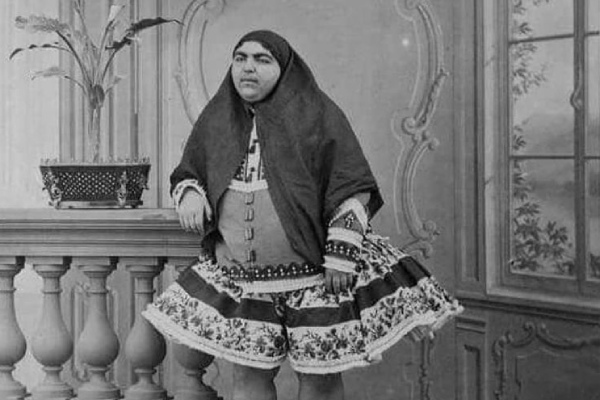What is the definition of perfection? What is the definition of beauty? Beauty is a term with ever-changing standards and definitions, and we certainly don’t have the perfect definition. We have an interesting piece for you to read on how the concept has evolved over time.
You may have heard of Princess Qajar, who has recently become a popular internet persona. People all across the internet have started fitting Princess Qajar into their made-up stories as if they’ve been obliged to provide things about her that they don’t know about her because of the growing interest in her. As a result, we wrote this essay to protect you from half-truths and fabrications. Read the entire article to learn how Princess Qajar became Persia’s beauty icon and why she is known as “Beauty with a Mustache.”
Princess Qajar: Who Was She?
There are two different princesses associated with the term Princess Qajar, contrary to memes and many posts circulating on the internet that show multiple photographs of the princess claiming to be the same person. Princess Fatemeh Khanum, also known as ‘Esmat al-Dowleh,’ was the daughter of Nasir al-Din Shah Qajar, the King of Persia from 1848 to 1896. Esmat was the daughter of King Nasir and Taj al-Dowleh, one of his wives. While many people assumed the photo was of a male actor, it is, in fact, a photograph of the Princess taken by her husband, Dust Muhammad Khan.
Zahra Khanum or Taj al-Saltaneh, the 12th daughter of Nasir al-Din Shah Qajar and half-sister of Esmat, is the other princess known as the Princess Qajar. Zahra’s inclusion in the meme stemmed from a hazy Princess Qajar reference, despite the fact that none of them were titled Princess Qajar but were both members of the Qajar family. The addition of Zahra came from the meme’s literal side, which claimed princess Qajar to be an activist, writer, and many other things.
Princess Qajar, Persia’s Symbol Of Beauty Why is she known as the “Beauty with a Mustache”?
Now that you know who Princess Qajar or Esmat al-Dowleh was, let’s look at how she came to be renowned as a symbol of beauty. First and foremost, contrary to popular belief, Esmat was not a symbol of beauty in the early 1900s, as photographs of her were shot much earlier, and she died in 1905. The only aspect of the story that is true is that Esmat’s look or having a thin mustache was once regarded attractive in Persian history. But her symbolism isn’t solely for that reason. There’s a lot more to it than meets the eye, in fact.
Esmat was King Nasir’s second daughter, and he had entrusted her with the job of hosting female foreign visitors to the court. She also defied convention by learning to play the piano and establishing a private photography studio in her home.
Princess Qasar was notable for her innovative ideas and bold feminism. Social media is the source of this image.
Esmat had the audacity to speak up for herself, as seen by her request to her father to allow her husband to return to the nation. Like other royal women, she presented herself as a capable woman at her father’s court. The portraits of Nasir al-Din Shah Qajar’s harem women reveal that they had formed a revolutionary consciousness, according to art historian Dr. Staci Gem Scheiwiller, and the sheer volume of Esmat’s photos finally made her the front and center of this social and cultural revolution. As a result, her symbolism has far more significance than simply enticing suitors.
The claim that 13 men committed themselves as a result of rejection appears to be a hoax.
Another false allegation coming from this historical rumor was that 13 men committed suicide after being rejected by Princess Qajar. However, there is no historical evidence to support this claim, and it appears to have been made up out of thin air. Esmat was most likely married when she was nine or ten years old, considering her spouse was also 10 at the time. Furthermore, as a member of a patriarchal society in ancient Iran, she had little opportunity to meet any guy, let alone reject 13 partners. She was unlikely to be approached by suitors even after her marriage.
Princess Zahra Khanum ‘Taj al-Saltaneh’ was an activist for women’s rights.
Because of the ambiguous Princess Qajar connection, Princess Zahra Khanum has been added to the plot. Zahra was a pioneer feminist and nationalist who championed a cultural and constitutional revolution in Persia as the 12th daughter of King Nasir. She was a driving force in improving women’s lives in that age, presenting some of the most compelling reasons for women’s participation in education, paid job, and the country’s progress.
Esmat and Taj were both defined by their achievements in transforming women’s roles, not by their physical attractiveness. Their meaning comes from their worth and content, not from copying or creating a standard for beauty. The stories of both Princesses must be conveyed in a way that honors rather than undermines their achievements. Overall, ‘Princess Qajar’ has demonstrated how historical memes can lead to a slew of falsehoods and frauds.
Follow Biography Line for more information about Entertainment, Celebrity Babies, YouTubers, and Movies & TV Series.














